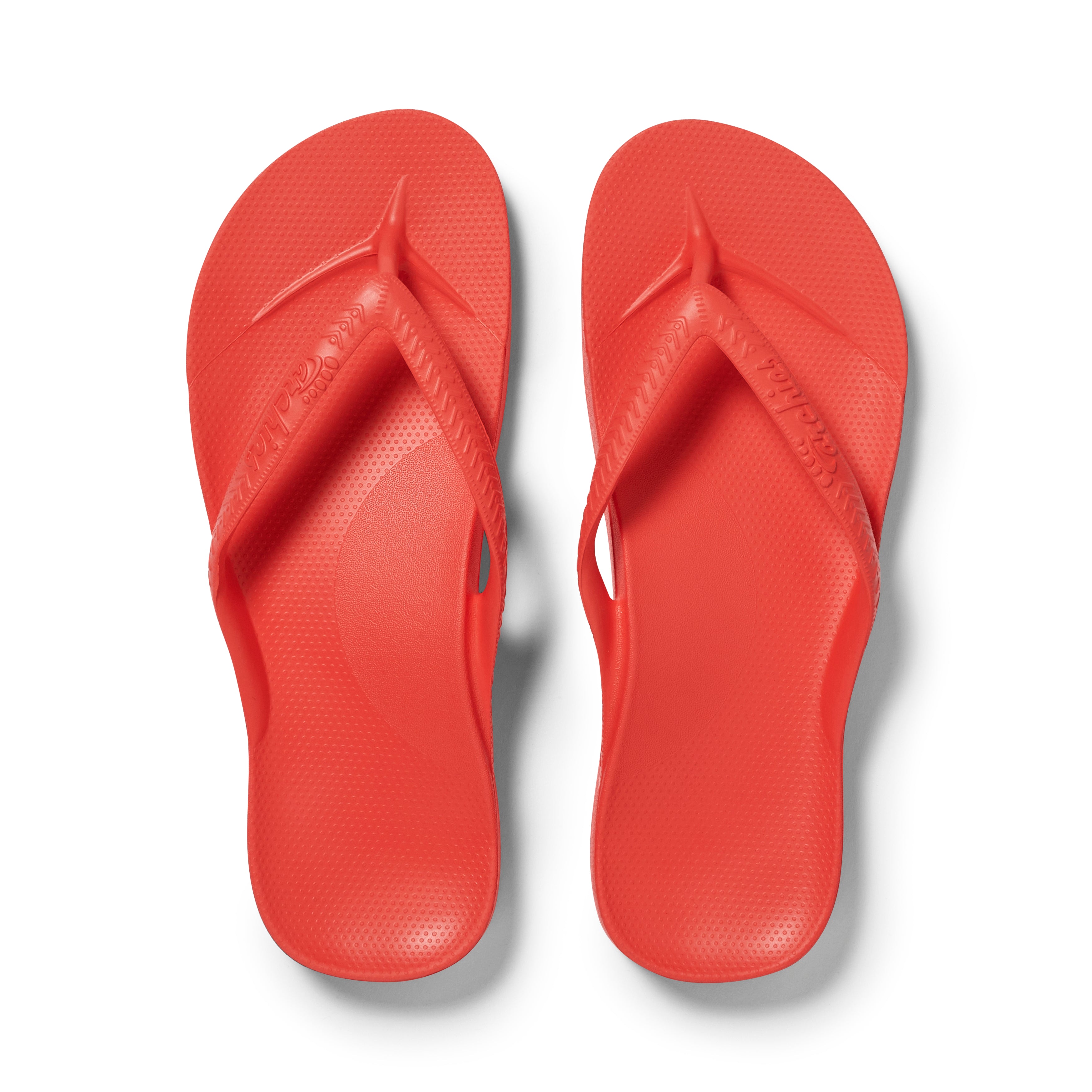What’s actually wrong with typical thongs?
At the start of every summer there seems to be some form of article in the newspaper or a T.V interview about the negative effects of typical flat thong wearing, in fact many elite sports teams which have actually banned their athletes from wearing flat thongs! While we are all reasonably aware that flat thongs are not great for your feet, what’s actually wrong with normal thongs?
The most obvious problem with typical thongs is that they are flat and offer the feet no support. This can be a problem for all foot types as we have become conditioned to wearing footwear with support, however it is a particularly a problem if you have increased pronation.

Pronation occurs when the foot rolls inwards. A small amount of pronation is an essential part of the gait cycle as it helps provide shock absorption and allows the foot to adapt to uneven surfaces, however, it becomes problematic when pronation is increased. In flat thongs, when pronation is increased, there is nothing to help support the foot in an optimal position and subsequently the foot rolls in and so too does the lower limb/leg, causing a disruption to the body’s natural alignment. Increased pronation alters the way that stress and strain are absorbed through the body, which can potentially lead to injury. Issues arising from increased pronation are more common in people with flat feet, however it can occur in all foot types. Common problems associated with increased pronation include bunions, plantar fasciitis as well as different forms of knee, hip and low back pain.
Flat thongs can also be problematic for people with high arches. People with high arches are more likely to supinate (roll outwards) and have a tendency to take increased stress on the outside of the foot and leg over time this uneven distribution of stress may lead to injury. The addition of arch support in this foot type can help more evenly distribute the load and pressure across the foot which may potentially reduce the stress on the lateral aspect of the foot and leg thereby reducing the likelihood of an injury from occurring. Common problems associated with this uneven distribution of load and pressure across the foot such as that seen in people with high arches include plantar fasciitis, bone stress related injuries, lateral shin problems and lateral knee problems.
What about going bare-feet? The big issue of loose fitting straps in typical thongs!
I am sometimes asked, what’s the difference wearing thongs compared to walking around barefoot? It’s a good question and one that’s fairly easy to answer. Walking barefoot can be great, particularly if you have a musculoskeletal problem which may be benefit from strengthening the intrinsic muscles of the feet and leg. However, it has already been mentioned that we have become accustomed to wearing shoes with support and when you take this support away, it can become problematic. You will be amazed how far we walk on a daily basis, the advent of smart phones and GPS tracking are testament to this. Most people are probably fine to walk barefoot around the house or on the grass in the backyard for short periods, however, if you were to walk 5 km in barefoot could you say the same thing? Even walking that distance on soft grass would surely be difficult. I think that it’s reasonable to say, that if most people were to walk any prolonged distance in bare feet that most people would start to get sore.
What compounds this even further in comparison to walking in typical flat thongs rather than walking bare feet, is that in typical thongs with loose straps, there is a complete obliteration of the normal gait cycle due to interference to the process whereby the arch of the foot is enhanced. This may be in fact may be one of the greatest flaws in the design of typical thongs, possible even more so than the lack of arch support!
Normally when you walk your toes are supposed to bend upwards which activates the arch of the foot which then provides protection and support to the vital structures of the feet. However, most typical thongs have loose straps, this means that the user ends up clawing / scrunching their toes down just to try and keep the thongs on their feet. When the toes claw / scrunch down rather than bending up, the arch does not activate correctly (the arch collapses) and as a result your foot is susceptible to increased stress and strain which may lead to damage of some of the vital structures of the feet such as the plantar fascia and joint surfaces.
Other issues with thongs:
Most thongs are very flat in the heel section with little to no elevation which can put a lot of stress and strain on the Calf and Achilles tendon. The lower your heel is to the ground, the more your Achilles will be on constant stretch which can predispose the user to problems such as Achilles tendinosis. Frequently referred to as the ‘pitch’ or ‘heel drop’ which is somewhat of ‘holy grail’ in supportive footwear, having some heel elevation help to unload the Achilles, thereby providing the users Achilles tendon with some relief from constant stress by being in a flat position.
Other more obvious problems with typical thongs is that they are commonly have straps that are made out of hard plastic which can cause irritation and can potentially lead to blisters. These straps also often more easily break at the toe pole by having the plug pull through the base of the thong, splitting the thong in the process.
Anyway, now when someone says thongs are not the best form of footwear for your feet, you have an understanding of why!
- การเลือกตัวเลือกจะส่งผลให้มีการรีเฟรชทั้งหน้า



